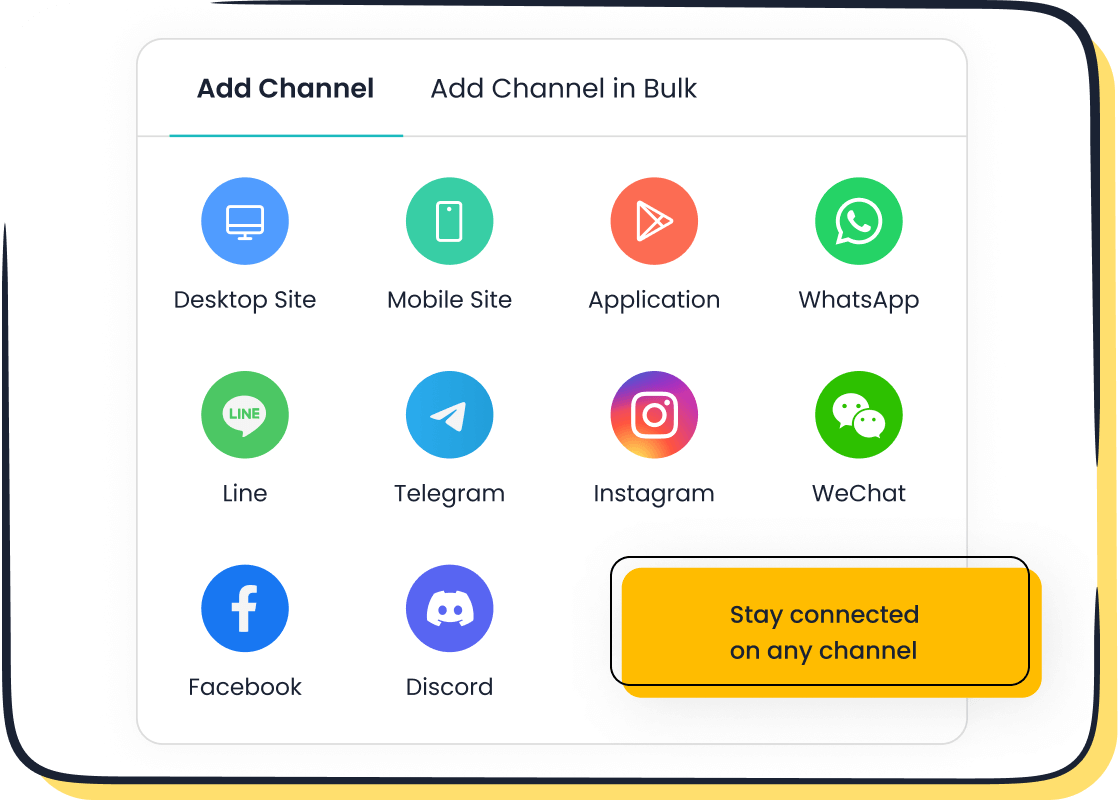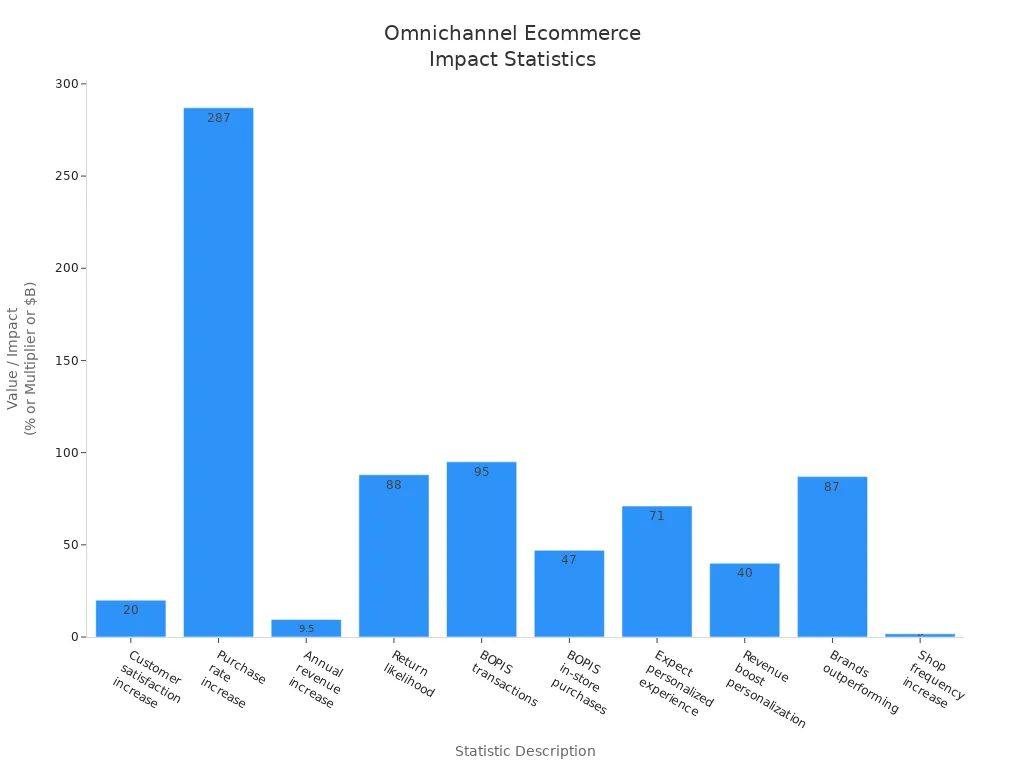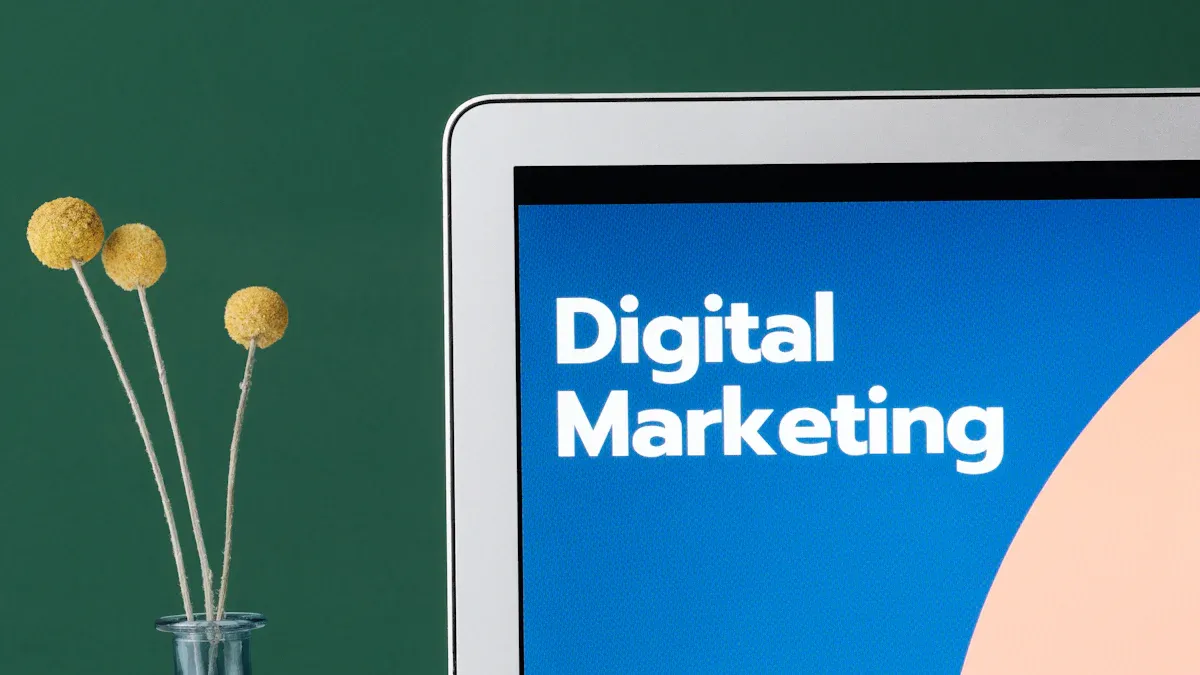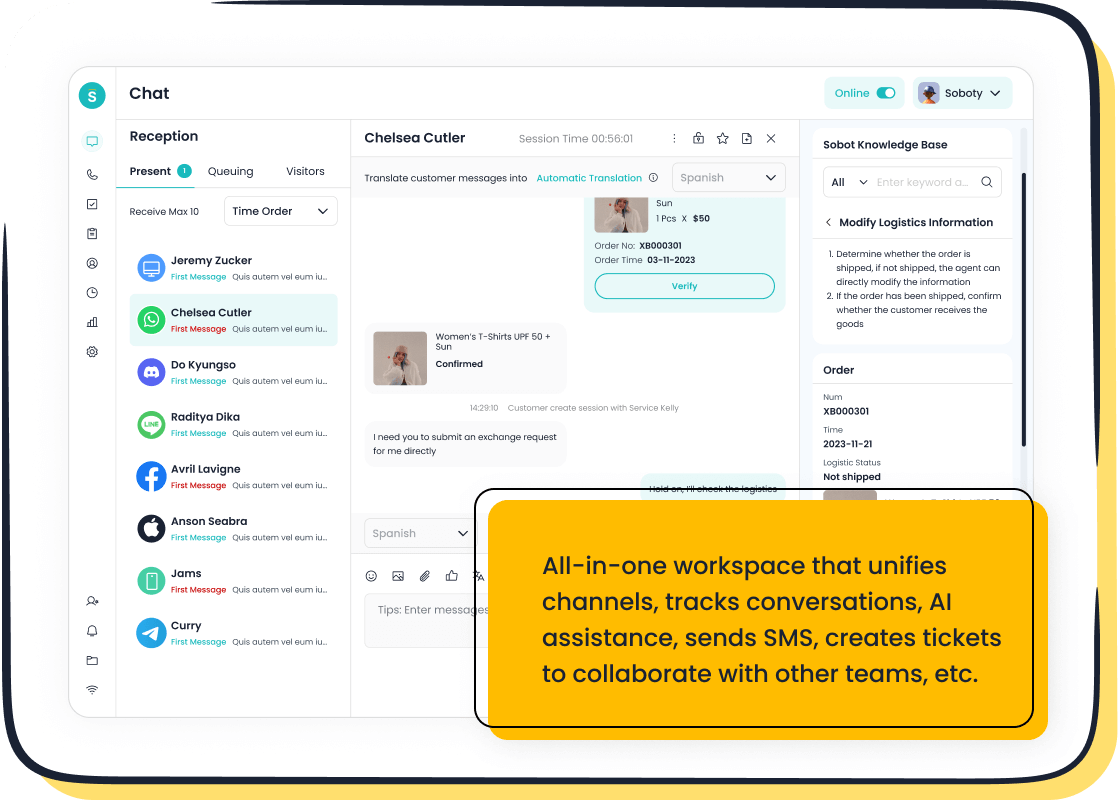How to Choose the Right Omnichannel Ecommerce Platform Today

Choosing the right omnichannel ecommerce software can boost your customer satisfaction by 20% and help your business grow faster. When you connect all your sales and support channels, shoppers become 88% more likely to return, and your revenue can increase by 9.5%. Take a look at how strong omnichannel platforms make a difference:
| Statistic Description | Statistic Value / Impact |
|---|---|
| Increase in customer satisfaction through personalization | 20% increase |
| Higher purchase rates with multi-channel marketing campaigns | 287% higher purchase rates |
| Annual revenue increase for brands with strong omnichannel | 9.5% increase |
| Likelihood of shoppers returning with connected omnichannel | 88% more likely to return |

Managing many channels can get messy. You might struggle with inventory, branding, or customer support. Sobot helps you bring everything together with smart tools like Sobot AI and the Sobot call center, so you can keep customers happy and your business running smoothly.
Key Criteria
Choosing the right omnichannel ecommerce software means looking at four key things: integration, scalability, security, and customer experience. Let’s break down why each one matters for your business.
Integration
You want all your channels—website, app, social media, and even your physical store—to work together. Integration makes this possible. When your systems connect, you get a full view of each customer. For example, Nike links its website, app, and stores so you can pick up where you left off, no matter where you shop. This kind of integration lets you offer smooth, personalized service. If your channels stay separate, you risk confusing customers and missing out on sales. Sobot’s unified workspace brings all your messages and data together, so your team can see every customer’s journey and respond quickly.
Scalability
Your business will grow. You need omnichannel ecommerce software that grows with you. A scalable platform handles more customers, more products, and more orders without slowing down. Cloud-based systems and modular designs help you add new channels or features as you need them. For example:
- You can handle more website visitors during a big sale.
- You can add new payment options or connect to new marketplaces.
- You can expand to new countries with multi-language and multi-currency support.
Sobot’s platform uses cloud technology and flexible integrations, so you never outgrow your system.
Security
Security keeps your business and customers safe. Every new channel—like social media or mobile apps—adds risk. Hackers look for weak spots, like unsecured APIs or fake storefronts. You need strong security across every channel. This means using safe connections, watching for fraud, and keeping customer data private. Sobot’s platform uses advanced security tools and regular updates to protect your data and build trust with your customers.
Customer Experience
Customer experience is everything. People want fast, friendly, and helpful service. Research shows 80% of shoppers care as much about service as they do about products. When you use omnichannel ecommerce software, you can give customers a smooth journey. They can start shopping on your website, ask questions on social media, and finish their order in your app—without repeating themselves. Sobot’s AI tools and analytics help you personalize every interaction, making customers feel valued and more likely to return.
Tip: Focus on these four criteria when you compare platforms. The right choice will help you grow, keep customers happy, and stay ahead of the competition.
What Is Omnichannel Ecommerce Software

Definition
Omnichannel ecommerce software helps you connect all your sales and support channels into one smooth system. Industry experts say this software creates a seamless and unified customer experience. You can move from your website to your app, then to your store, and never lose your place. The software links your online store, mobile app, social media, and even your physical shop. You get one view of your customer, and your customer gets one brand experience. This is different from multichannel systems, where each channel works alone. With omnichannel ecommerce software, everything works together. You can track inventory, manage orders, and talk to customers without switching tools.
Benefits
You get many benefits when you use omnichannel ecommerce software. Here’s a quick look:
| Benefit Category | Description |
|---|---|
| Improved Customer Experience | Customers can shop across platforms without any hassle. |
| Synchronized Inventory | You see all your stock in one place, so you avoid running out or overstocking. |
| Personalized Marketing | You send the right message to the right person at the right time. |
| Consistent Branding & Communication | Your brand looks and sounds the same everywhere. |
| Flexible Fulfillment Options | Customers can buy online and pick up in-store, or get same-day delivery. |
| Increased Profits | Happy customers buy more, so your revenue goes up. |
| Meeting Customer Expectations | You give shoppers the smooth, connected journey they want. |
Note: Research shows that businesses using omnichannel ecommerce software see higher profits and better customer loyalty. Source
Sobot’s Approach
Sobot takes omnichannel ecommerce software to the next level. You get a single platform that brings together all your channels—like Amazon, Shopify, WhatsApp, Facebook, and your website—into one AI-powered workspace. Here’s what makes Sobot stand out:
- Sobot unifies every customer message, order, and data point in one place.
- You can use Sobot’s Live Chat to talk to customers on their favorite channels, from Instagram to Telegram.
- Sobot’s Five-AI system helps you answer questions fast, automate tasks, and even predict what your customers need.
- The platform supports over 50 languages, so you can grow your business anywhere.
- Sobot’s real-time analytics show you what’s working and where to improve.
With Sobot, you don’t need to juggle different tools. You get a complete, easy-to-use solution that helps you deliver a great customer experience every time.
Essential Features
When you look for the best omnichannel ecommerce software, you want to make sure it has the right features. These features help you connect with your customers, make smart decisions, and grow your business. Let’s break down what you should look for:
Channel Support

Channel support means you can talk to your customers wherever they are—on your website, social media, email, or even in your store. With strong channel support, you keep all your conversations and data in one place. This makes it easy for customers to switch from chatting on Instagram to calling your support line without repeating themselves. Sobot Live Chat does this well by bringing together messages from WhatsApp, Facebook, Telegram, and more into one workspace. You get a full view of every customer, and they get a smooth, connected experience.
Tip: The more channels you support, the easier it is for customers to reach you. This builds trust and keeps them coming back.
Unified Data
Unified data means all your customer and order information lives in one system. You don’t have to jump between tools or worry about missing details. When you use omnichannel ecommerce software with unified data, you see everything in real time—inventory, orders, and customer history. This helps you make better decisions fast. For example, if a customer buys online and returns in-store, you see the whole story. Sobot’s unified workspace gives you this single source of truth, so you can personalize service and avoid mistakes.
Automation
Automation saves you time and reduces errors. You can set up automatic replies, order updates, and even marketing messages. Leading platforms use AI to handle simple questions, route tickets, and send reminders. Sobot Live Chat uses AI tools to help agents respond faster and automate routine tasks. This means your team can focus on helping customers with bigger problems, while the software takes care of the rest.
- Examples of automation:
- Auto-assigning tickets to the right agent
- Sending order confirmations instantly
- Reminding customers about abandoned carts
Analytics
Analytics help you see what’s working and what needs improvement. With good analytics, you track customer behavior, sales trends, and service quality. You can spot problems early and find new ways to grow. Sobot Live Chat offers built-in analytics that measure over 150 indicators, so you always know how your team is doing. You can use these insights to boost conversion rates and keep customers happy.
- Analytics tools can:
- Show which channels get the most questions
- Track how fast your team responds
- Help you test new ideas with A/B testing
Personalization
Personalization makes every customer feel special. You use data to send the right message at the right time, suggest products they’ll love, and offer deals just for them. Brands that use personalization see higher sales and more loyal customers. For example, some companies have boosted conversion rates by 30% just by tailoring their website for different regions. Sobot’s AI-powered tools help you segment customers and deliver personalized service across all channels.
Note: Personalization isn’t just a nice-to-have—it’s a must if you want to stand out and keep customers coming back.
Selection Steps
Choosing the right omnichannel ecommerce software can feel overwhelming, but you can break it down into five clear steps. Follow this guide to make a smart, confident decision for your business.
Assess Needs
Start by understanding what your business and your customers really need. This step helps you avoid buying software that doesn’t fit or missing out on features that matter.
- Know Your Audience
Think about who your customers are. When do they shop? Where do they spend time online? How do they like to buy things? - Walk in Their Shoes
Try shopping from your own store using different channels—website, app, social media. Notice what feels easy and what feels frustrating. - Ask for Feedback
Talk to your customers. Use surveys or quick polls. Offer a small reward for their opinions. Their answers will show you what to fix or improve. - Check the Data
Look at your sales numbers, website visits, and social media stats. Use keyword research tools to see what people search for. - Personalize and Segment
Group your customers by what they like, how they shop, or how often they buy. Send messages that match their interests. - Automate Where Possible
Set up automatic messages for things like order updates or reminders. This keeps customers engaged without extra work.
Tip: Map out the whole customer journey, from first visit to repeat purchase. This helps you spot gaps and opportunities.
Compare Options
Now, look at different platforms and see which one matches your needs best. Don’t just go for the most popular name—focus on what works for you.
- Core Features
Make sure the platform syncs inventory, combines customer profiles, and supports both online and offline sales. Real-time analytics and flexible payment options are a must. - Special Extras
Look for things like AI-powered personalization, multi-channel selling, or even AR/VR features if you want to stand out. - Easy to Use
The software should feel simple. You want clear menus, easy product management, and smooth order processing. - Onboarding and Support
Good platforms offer training, setup help, and templates. Check if they have 24/7 support or a helpful knowledge base. - Value for Money
Compare prices, but also check what you get for your money. Free trials or demos are a big plus.
Here’s a quick checklist to help you compare:
| Criteria | What to Look For |
|---|---|
| Core Functionality | Inventory sync, unified profiles, analytics |
| Standout Features | AI, AR/VR, eco-shipping, blockchain |
| Usability | Easy navigation, clear dashboard |
| Onboarding | Training, setup wizards, templates |
| Customer Support | 24/7 help, knowledge base, fast response |
| Value for Money | Transparent pricing, free trial/demo |
Note: Sobot offers a free trial and live demo, so you can test features and see if it fits your business before making a commitment. Most users prefer to try software before buying, and this step can boost your confidence in your choice.
Test Integrations
You want your new software to work with the tools you already use. Testing integrations helps you avoid headaches later.
- Run Test Transactions
Try buying something, updating inventory, and checking customer data. Make sure everything syncs across channels. - Simulate Busy Times
Pretend it’s Black Friday. Can the system handle lots of orders at once? Does it keep up with inventory changes? - Check Data Accuracy
Make sure customer info, orders, and inventory match everywhere. No one likes surprises at checkout. - Monitor Performance
Watch for slowdowns or errors. Review logs and metrics to catch problems early. - Update Regularly
Keep your systems and integrations up to date. This helps you stay secure and ready for new channels.
Pro Tip: Sobot’s omnichannel ecommerce software connects with popular tools like Shopify, Salesforce, and WhatsApp. You can test these integrations during your free trial to see how well everything works together.
Review Security
Security protects your business and your customers. Don’t skip this step.
- Check Compliance
Make sure the platform follows rules like PCI DSS for payments, GDPR and CCPA for data privacy. - Look for Encryption
Data should be encrypted from end to end. This keeps customer info safe. - Access Controls
Only the right people should see sensitive data. Set up roles and permissions. - Fraud Monitoring
The software should spot and stop suspicious activity. - Regular Audits
Ask if the platform does regular security checks and updates.
Note: Sobot’s platform uses advanced security tools and meets industry standards, so you can trust your data is safe.
Evaluate Costs
Don’t just look at the price tag. Think about all the costs over time.
| Cost Category | What to Consider |
|---|---|
| Software Licensing | Subscription fees, one-time payments, what’s included (support, updates, hosting) |
| Integration Fees | Costs to connect with other tools or partners |
| Infrastructure Fees | Hosting, domain names, security certificates |
| Operational Costs | Maintenance, bug fixes, support response time |
| R&D | Custom features or upgrades |
| External Resources | Hiring outside help for setup, migration, or SEO |
| Platform Upgrades | Regular updates, especially for SaaS platforms |
| Pricing Models | Transaction fees, revenue tiers, or percentage of sales |
- Initial Costs
Think about setup, training, and connecting your current systems. - Ongoing Costs
Include monthly fees, transaction charges, and marketing expenses. - Hidden Costs
Watch for extra charges for support, upgrades, or custom features.
Try using a TCO (Total Cost of Ownership) calculator to see the real cost over several years. Free trials and demos, like those from Sobot, let you test everything before you commit. This helps you avoid surprises and make a smart investment.
By following these steps, you can choose omnichannel ecommerce software that fits your business, keeps your customers happy, and grows with you. Don’t rush—take your time, test everything, and use free trials to make sure you’re making the right choice.
Success Stories

Opay Case
Let’s look at how Opay, a leading financial service platform, transformed its business with Sobot’s omnichannel ecommerce platform. Before using Sobot, Opay struggled to keep up with customer questions across different channels. Customers often waited too long for help, and the team found it hard to manage everything in one place.
After switching to Sobot’s omnichannel solution, Opay saw big changes:
| Aspect | Description | Result/Impact |
|---|---|---|
| Customer Satisfaction | Improved from 60% to 90% after using Sobot’s platform. | +30% satisfaction |
| Cost Reduction | Automation and better workflows cut costs by over 20%. | >20% cost savings |
| Conversion Rate | Better engagement and marketing boosted conversions by 17%. | +17% conversion rate |
You can see how Sobot’s AI Chatbot and Voicebot made a difference. These tools handled simple questions, so agents could focus on tougher problems. Opay also used Sobot’s WhatsApp Business Account to reach more customers and send targeted messages. The result? Faster service, happier customers, and more sales.
Did you know? Opay’s team reduced their workload and saved money by automating routine tasks. They also improved their marketing with AI-powered calls and smart customer tagging.
Industry Impact
Opay isn’t the only brand seeing results with Sobot’s omnichannel ecommerce platform. Many well-known companies across retail, electronics, and services have made the switch. For example, OPPO, a top smart device brand, used Sobot’s chatbot to handle repetitive questions. This freed up their agents to solve complex issues, leading to an 83% resolution rate and a 94% positive feedback score.
Here are just a few brands using Sobot’s solutions:
| Notable Brands Using Sobot’s Omnichannel Ecommerce Platform |
|---|
| Samsung |
| OPPO |
| OnePlus |
| Weee! |
| Michael Kors |
| J&T Express |
| OPay |
| Mico |
You can see how Sobot’s platform helps businesses in different industries connect with customers, improve service, and grow faster. If you want to boost your own results, an omnichannel ecommerce platform like Sobot can make a real difference.
Choosing the right platform starts with clear steps. Look for social media integration, easy management, strong security, and reliable support. Make sure the software can handle big catalogs and offers features like automation and real-time data. Companies that get this right see higher sales, better customer loyalty, and smoother operations. Start your evaluation today—Sobot’s solutions help you stay ahead and build lasting success.
FAQ
What is an omnichannel ecommerce platform?
An omnichannel ecommerce platform lets you connect all your sales and support channels. You can manage your website, social media, and even your store in one place. This helps you give customers a smooth shopping experience every time.
Why should I use an omnichannel ecommerce platform for my business?
You boost customer satisfaction and sales when you use an omnichannel ecommerce platform. Studies show brands with strong omnichannel strategies see a 9.5% increase in annual revenue. You also make it easier for customers to shop and get support. Source
How does Sobot help with omnichannel ecommerce?
Sobot brings all your customer messages, orders, and data into one workspace. You can chat with customers on WhatsApp, Facebook, or your website without switching tools. Sobot’s AI tools help you answer questions fast and keep customers happy. Learn more at Sobot Live Chat.
Can I try Sobot’s omnichannel ecommerce platform before buying?
Yes! Sobot offers a free trial. You can test all the features, connect your channels, and see how the omnichannel ecommerce platform fits your business. Just visit Sobot’s website to get started.
What features should I look for in an omnichannel ecommerce platform?
Look for channel support, unified data, automation, analytics, and personalization. Sobot’s omnichannel ecommerce platform gives you all these features. You can manage everything in one place and use AI to boost your team’s efficiency.
See Also
Complete Overview Of Omnichannel Software For Call Centers
How To Successfully Deploy Omnichannel Contact Center Solutions
Best Live Chat Platforms For Ecommerce Businesses In 2024
Comparing The Leading Live Chat Tools For Shopify Stores
Explore Twelve Live Chat Applications To Boost Shopify Sales
